10 Powerful Creative Thinking Exercises to Unlock Your Innovation Potential
January 28, 2025
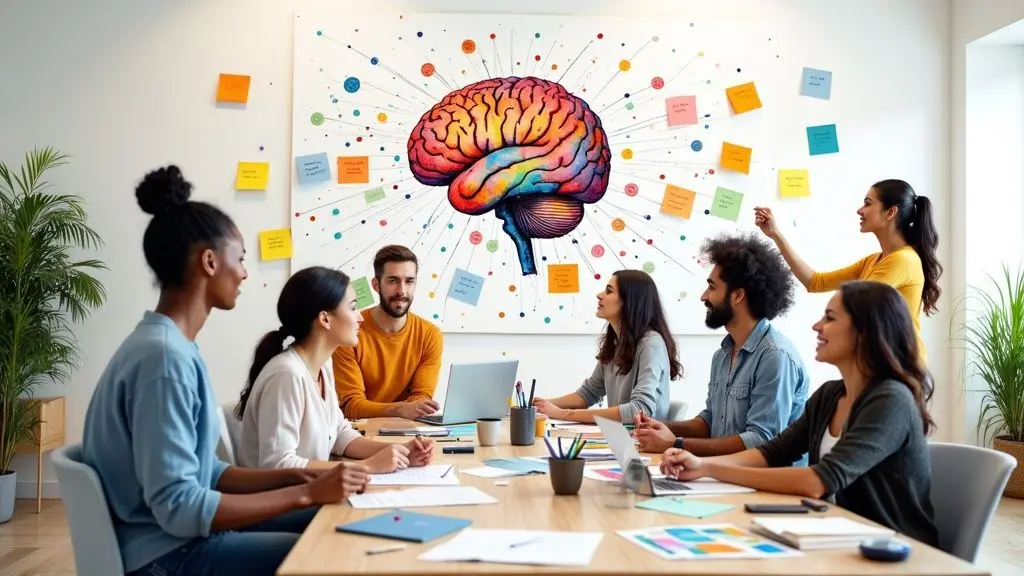
The Science of Creative Thinking: Understanding Your Brain's Innovation Engine
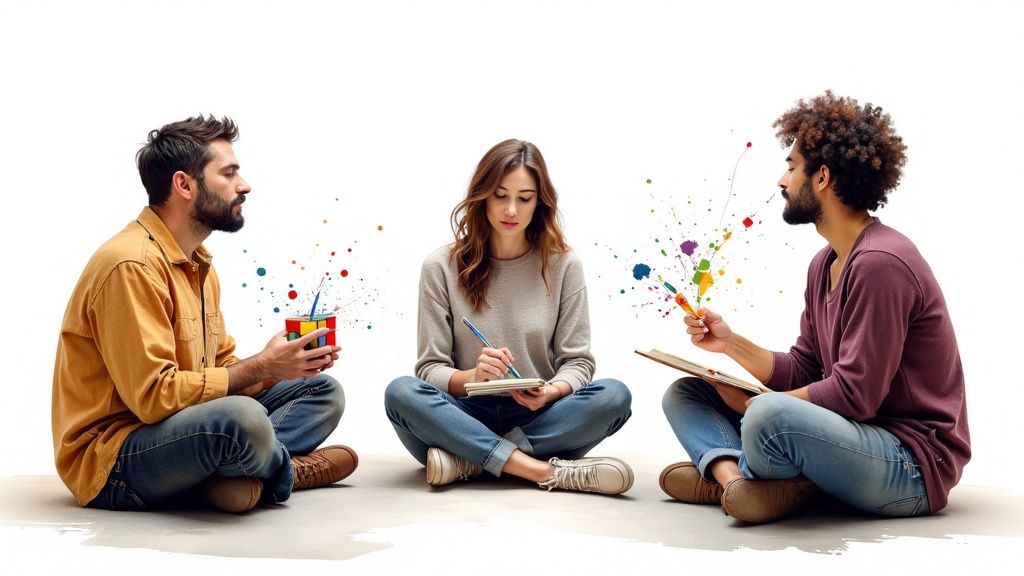
Ever wonder what actually happens in your brain when you have a brilliant idea? Creative thinking isn't some mysterious talent that only a lucky few possess - it's a natural process that happens in everyone's brain. By understanding how our minds generate new ideas, we can learn to boost our creative abilities through targeted practice and exercises.
The Neuroscience of Novel Ideas
Your brain is like a master chef, combining ingredients from different regions to cook up new ideas. The prefrontal cortex acts as the head chef, deciding which ingredients to use and how to combine them. Meanwhile, the hippocampus works as the pantry manager, pulling out relevant memories and experiences that might work well together. When these brain areas work in sync, they create fresh connections that lead to original thoughts and solutions.
Why Traditional Approaches Fall Short
You've probably sat through countless brainstorming sessions where the goal was simply to generate as many ideas as possible. While this might seem logical, research shows it often leads to idea fatigue - that mental burnout where you can't think of anything new. This happens because rapid-fire idea generation doesn't give your brain's creative centers enough time to form meaningful connections. Instead, focused exercises that target specific problems tend to produce better results. You might be interested in: An Adult's Guide to Coloring.
The Decline in Creative Thinking
The data on children's creativity presents a concerning picture. Studies tracking creativity scores among 300,000 U.S. students have shown a significant drop since 1990, with younger kids showing the steepest decline. This trend highlights why we need to actively nurture creative thinking skills from an early age. Learn more about this creativity crisis at The Child Creativity Lab.
Enhancing Creative Capabilities
The good news is that you can strengthen your creative muscles through simple daily practices. Activities like meditation and regular exercise help your brain form new neural pathways - think of it as creating new roads for ideas to travel on. These practices make your mind more flexible and better at generating fresh solutions. When you understand these biological processes, you can choose activities that specifically target and improve your creative abilities.
Movement and Innovation: Unlocking Creativity Through Physical Activity
Being active and thinking creatively are naturally connected, even though we don't always link them in our minds. Regular movement - whether it's a brisk walk, gentle stretching, or an energetic workout - helps spark fresh ideas and new ways of thinking. When you're feeling stuck on a creative project, getting your body moving could be exactly what your mind needs.
The Science Behind Movement and Creativity
Moving your body directly affects how your brain works. Physical activity boosts blood flow and oxygen to your brain cells, feeding the areas that drive creative thinking. When you move, your brain releases chemicals that help improve memory, sharpen focus, and generate new ideas. Exercise also naturally reduces stress and worry, putting your mind in a more open and relaxed state. This mental clarity makes it easier to see unexpected connections and think more freely.
Real-World Applications: How Innovators Use Movement
Many successful people have discovered this brain-body connection and made movement part of their creative routine. Some hold walking meetings to generate better ideas, while others use yoga or other exercise to work through mental roadblocks. Steve Jobs famously preferred walking meetings, believing they led to more productive and creative conversations. The research supports this approach - a study of 79 adults showed that physically active people came up with more original ideas than those who were less active. Learn more about this connection: Exercise and Mental Health Research.
Practical Creative Thinking Exercises Involving Movement
Here are simple ways to combine movement with creative thinking:
- Walking Brainstorm: Step outside and walk while working through a problem. New surroundings and steady movement often trigger fresh perspectives.
- Movement Meditation: Mix gentle movement like stretching or tai chi with focused thinking about your project.
- Improvisational Dance: Move freely without planning - this helps unlock more spontaneous thinking.
- Nature Walk and Idea Capture: Take notes while walking outdoors, letting natural surroundings inspire new thoughts.
Building an Activity-Based Creative Practice
You don't need to completely change your routine to benefit from movement. Start with small steps: take a short walk during lunch, choose stairs over elevators, or do quick stretches at your desk. Pick activities you actually enjoy and that fit naturally into your day. These simple changes, practiced regularly, can make a real difference in how you solve problems and generate ideas.
Walking Your Way to Breakthrough Ideas
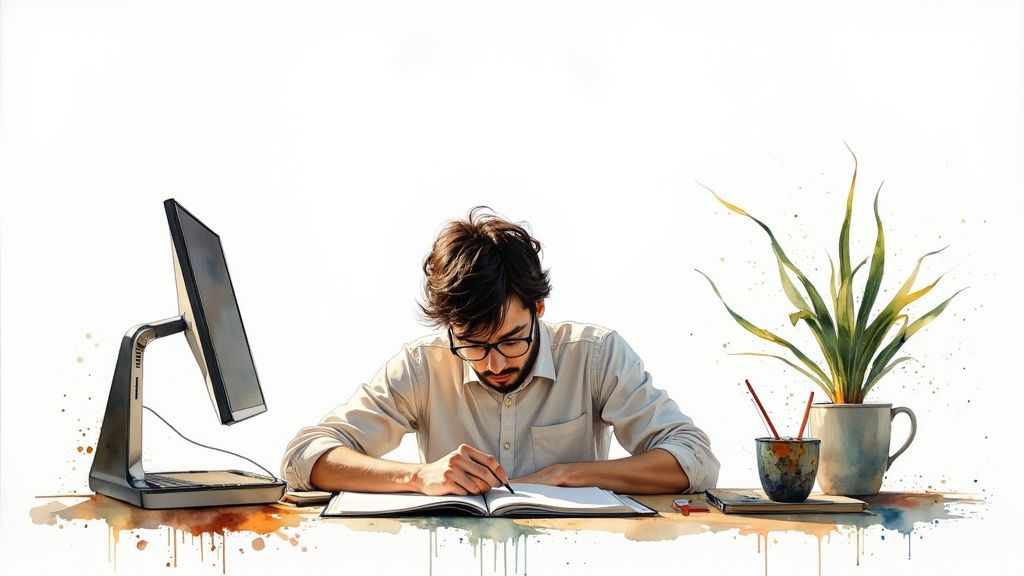
Want to boost your creativity? Take a walk. The simple act of walking stimulates our minds in remarkable ways. Whether you prefer solo strolls or walking meetings with colleagues, the right kind of walk can help you find fresh perspectives and solutions.
The Power of Peripatetic Thinking
The connection between walking and thinking goes back centuries. Ancient Greek philosophers like Aristotle taught their students while walking, a practice called peripatetic thinking. But this isn't just ancient wisdom - modern research backs it up. A fascinating Stanford study found that people who walked, whether inside or outside, showed 60% more creative output than those who stayed seated. Walking specifically helps with divergent thinking - our ability to come up with multiple solutions to problems. Learn more about the research here: Stanford Walking Study.
Structuring Your Creative Walks
Taking a walk with purpose makes all the difference. Start your problem-solving walk by clearly stating what challenge you want to tackle. As you walk, let your mind explore different angles of the problem. The physical movement often helps ideas flow more naturally.
Walking meetings offer another great option for team creativity. Moving together breaks down formal barriers and creates a more relaxed atmosphere. People tend to speak more freely and build on each other's ideas when they're walking side by side rather than sitting across a table.
Walking for Different Creative Challenges
Different types of walks serve different creative needs:
- Brainstorming Walk: Choose a lively route when you need lots of fresh ideas
- Focus Walk: Pick a quiet natural setting to concentrate deeply on one problem
- Reflection Walk: Take it slow when you need to process information and find clarity
Combining Walking with Other Creative Thinking Exercises
Walking works even better when paired with other creative practices. Try capturing ideas from your walk in a mind map afterward. Or bring a journal on your nature walk to write down insights as they come. These combinations help you make the most of your walking-inspired creativity.
Using Technology to Spark Creative Thinking
Digital tools offer powerful ways to enhance creativity and imagination. The key is finding ways to use technology thoughtfully while preserving the essential human elements that drive creative thinking. Let's explore some impactful approaches.
AI as a Creative Partner
Think of artificial intelligence not as a replacement for human creativity, but as a supportive collaborator. AI tools can help overcome common creative blocks by suggesting fresh angles and unexpected combinations. For instance, when facing writer's block, AI can propose different ways to phrase ideas or develop plot points. This frees up mental bandwidth for the deeper creative work of building engaging stories and exploring complex emotions.
Virtual Environments and the Imagination
Virtual reality and augmented reality create immersive spaces that can spark new ideas. Picture stepping into a virtual art studio to sketch concepts, wandering through a digital forest for inspiration, or meeting colleagues in shared online workspaces. These tools break down physical barriers while encouraging playful exploration that often leads to unexpected creative breakthroughs. You might be interested in: How visual learning strategies transform teaching.
Digital Platforms for Collaboration and Inspiration
Online creative communities connect you with fellow creators worldwide. Sharing work, exchanging feedback, and collaborating across borders exposes you to diverse perspectives that can reshape your thinking. These digital spaces help nurture new ideas through active discussion and experimentation. For example, educators are finding success with hands-on tech tools - a Saint Anselm College study showed strong student engagement when using drones to teach programming concepts. Learn more: Explore drones in education.
Building a Tech-Enhanced Creative Process
The most effective approach is choosing tools that support rather than override your natural creative process. Start by identifying specific areas where you need help - whether that's generating initial ideas, collaborating with others, or executing your vision. This helps you select technologies that directly address your creative challenges.
Evaluating the Impact of Technology on Creativity
It's worth regularly assessing how digital tools affect your creative work. Too much reliance on technology can sometimes get in the way of deep thinking and spontaneous discovery. Ask yourself: Do these tools help or hinder your creative flow? Are they opening up new possibilities or creating distractions? Regular reflection helps ensure technology remains a positive force in your creative growth.
Mastering Solo and Group Creative Thinking Techniques
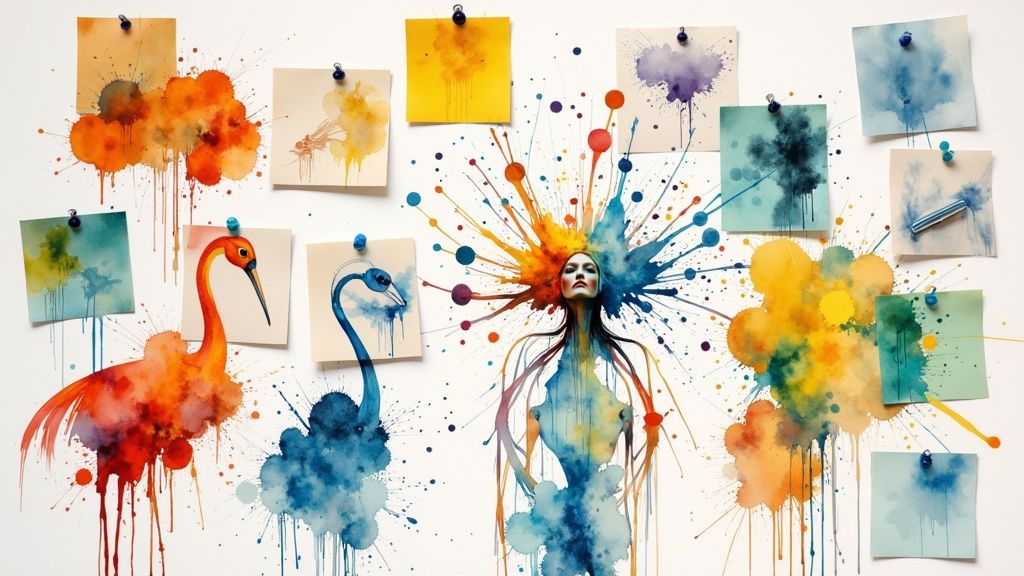
Good ideas can spark when you're alone with your thoughts or bouncing ideas around with others. Both approaches have their place in the creative process. Let's explore how to get the most out of individual reflection and group brainstorming to generate your best ideas.
The Power of Solo Ideation
Working alone gives your mind the quiet space it needs to dive deep. During these focused moments, your brain keeps processing ideas in the background through incubation - that's why brilliant solutions often pop up when you least expect them, like in the shower or on a walk. Solo work also lets you freely explore wild ideas without worrying what others might think. For more on finding your creative flow, check out A Complete Guide to Creative Relaxation with Adult Coloring Books.
Practical Frameworks for Personal Ideation
There are several proven techniques to make your solo creative sessions more productive. Try freewriting - just write non-stop for 10-15 minutes without editing or judging. This helps surface ideas hiding in your subconscious. Mind mapping lets you visually connect related concepts by drawing branches between them. Simple activities like taking a walk, sketching, or listening to music can also help shift your perspective and spark fresh thinking.
The Dynamics of Group Brainstorming
Group creative sessions tap into the power of different viewpoints and experiences. When diverse minds come together, they often generate ideas that no one person would have thought of alone. The energy of bouncing ideas back and forth can lead conversations in unexpected and exciting directions. Groups also create momentum through shared enthusiasm and building on each other's suggestions.
Effective Group Brainstorming Protocols
Good group brainstorming needs clear structure to work well. Start by clearly defining what problem you're trying to solve. Begin with individual ideation time - let everyone generate their own ideas first before sharing. This helps prevent groupthink, where people just agree with whatever idea comes up first. Create an environment where wild ideas are welcome and everyone feels safe speaking up. Having a facilitator guide the discussion helps keep things on track and ensures all voices get heard.
Combining Solo and Group Practices
The best results often come from mixing individual and group creative work. For example, start with solo reflection time, then bring those initial ideas to a group session where people can build on them together. Going back and forth between quiet individual work and lively group discussion throughout your creative process leads to stronger, more complete solutions that benefit from both deep personal insight and collective wisdom.
Building Your Daily Creative Practice
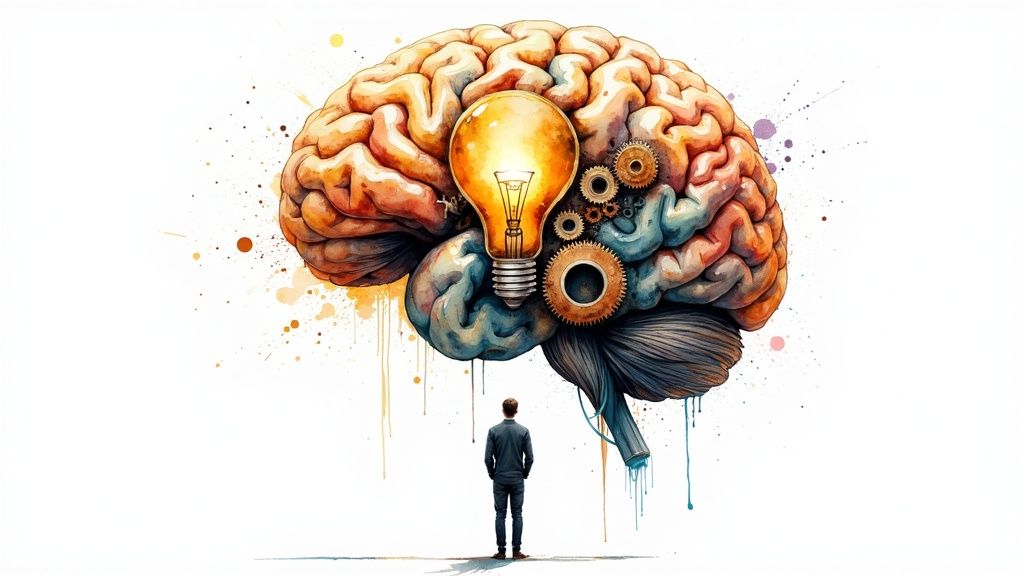
Like any skill worth mastering, creativity flourishes with regular practice. Think of it like tending a garden - you need consistent care and attention, not just occasional bursts of effort. Let's explore practical ways to weave creative thinking into your everyday routine.
Morning Creativity Rituals
Start your day by feeding your creative mind. Try freewriting for 10-15 minutes - just let your thoughts flow onto paper without editing or judgment. Or grab some paper and try mind mapping, where you visually connect related ideas around a central theme. Adding some light exercise, even a quick walk around the block, gets your blood flowing and mind humming with fresh ideas.
Lunch-Break Ideation Techniques
Your lunch break is perfect for a midday creativity boost. Take your sandwich outside for a "walking brainstorm" - pick a specific challenge to ponder while you move. Or find a quiet corner for 10 minutes of meditation, letting your mind wander freely. These brief creative breaks help you tackle afternoon work with renewed mental energy.
Evening Reflection Practices
As your day winds down, take time to review and reflect. A creative journal helps track your ideas and spot patterns in your thinking over time. Jot down what worked well, what didn't, and any fresh insights that emerged. Wind down with relaxing creative activities like coloring or sketching - they quiet your mind and set you up for quality rest.
Tracking Progress and Maintaining Motivation
Keep tabs on your creative growth by noting small wins and breakthroughs. Pay attention to when and how your best ideas emerge. Maybe morning freewriting sparks your imagination, or perhaps midday walks get your creative juices flowing. Adjust your routine based on what actually works for you, not what you think should work.
Creative Challenges and Continuous Growth
Shake things up regularly to keep growing. Try a new art form, join a creative project with others, or give yourself fun challenges like "sketch something red every day this week." Playing with different approaches not only prevents boredom but often reveals hidden talents and fresh ways of thinking.
Ready to spark your creativity? ColorPageAI fits perfectly into a daily creative practice. Whether you need a coloring break or visual inspiration, it's there to help unlock your imagination. Visit today and start exploring your creative potential!
Ready to start coloring?
Join ColorPage.ai today and get 5 free credits to create your own custom coloring pages!
Start creating